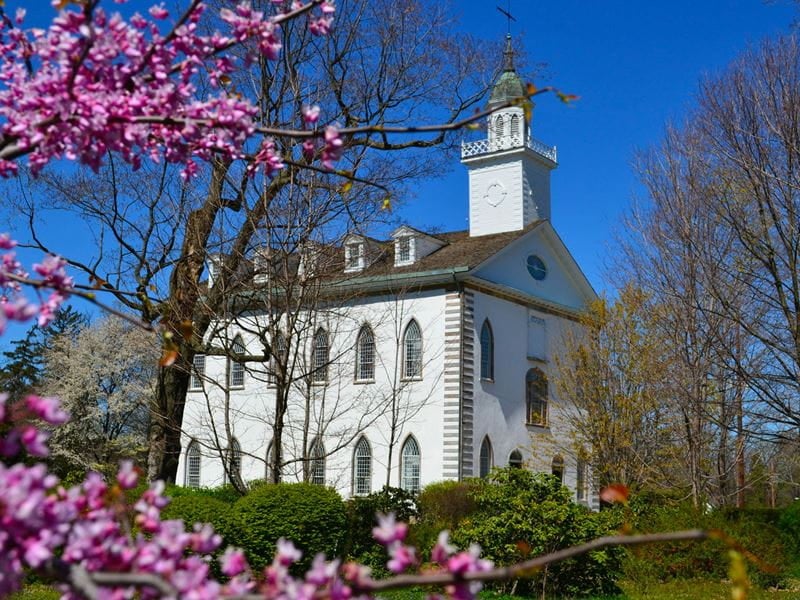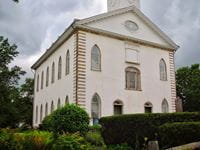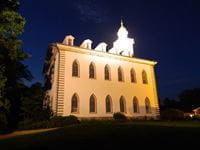
- Trending:
- Pope Francis
- |
- Resurrection
- |
- Trump
- |
- Social Justice
- |
- Peace
- |
- Love
The 100 Most Holy Places On Earth
Kirtland Temple





Associated Faiths:
The Church of Jesus Christ of Latter-day Saints and The Community of Christ
Accessibility:
Open to visitors.
Annual Visitors - 25,000
History
The Kirtland Temple holds a special place in the hearts of Latter-day Saints. This sacred building, located in Kirtland, Ohio, played a key role in the early days of the Latter-day Saint movement. Let's take a look at the history and importance of this holy site.
Construction on the Kirtland Temple began in 1833 under the direction of Joseph Smith, the founder of the Latter-day Saint faith. The Saints worked tirelessly to build the temple, even in the face of financial hardship and opposition from locals. Men donated time and labor while women produced tapestries and decorations for the interior. After three years of dedicated efforts, the temple was completed in 1836.
The finished temple was a sight to behold. The impressive exterior, with its gothic-inspired design, featured two large assembly halls and a top level for educational purposes. But the temple was more than just an architectural wonder - it was a sacred space where the Saints could worship, learn, and feel closer to God.
Many significant events took place within the walls of the Kirtland Temple. It was here that Joseph Smith and Oliver Cowdery reported visitations from Jesus Christ and important Biblical figures who restored priesthood authority and keys to them. The temple was also the site of powerful spiritual outpourings where many Saints experienced visions, speaking in tongues, prophecy and other spiritual manifestations.
Sadly, only two years after the temple's dedication, the Saints had to abandon Kirtland due to persecution and financial woes. As the Saints moved west, the temple was left behind. Over the following decades, the temple fell into disrepair as it changed hands several times.
In 1880, a group known as the Reorganized Church of Jesus Christ of Latter Day Saints gained possession of the temple. They worked to restore and preserve this important site. Recently, the temple and surrounding buildings were purchased by the Church of Jesus Christ of Latter-day Saints from the Community of Christ. Visitors of all faiths are welcome to tour the beautifully restored Kirtland Temple and learn about its fascinating history.
Nearly 200 years after its construction, the Kirtland Temple continues to stand as a monument to the faith and dedication of the early Latter-day Saints. It remains a sacred space and a reminder of the important role it played in the history of the Latter-day Saint movement. While the Kirtland Temple may not be used for ordinances like modern-day LDS temples, it is still a beloved and holy site for many in the Latter-day Saint community.
Whether you're a member of the Church of Jesus Christ of Latter-day Saints, the Community of Christ, or simply someone interested in religious history, a visit to the Kirtland Temple is an informative and moving experience. As you walk through its halls and learn about the sacrifices of the Saints who built it, you can't help but feel the spiritual significance of this special place. The Kirtland Temple isn't just a historical landmark - it's a sacred space that continues to inspire people nearly two centuries after its dedication.
Religious Significance
When we speak of “pilgrimage people,” perhaps Muslims, Hindus or Buddhists come to mind. Certainly, few would instantly think of members of The Church of Jesus Christ of Latter-day Saints (sometimes called “Mormons”). And yet, Latter-day Saint Christians have numerous pilgrimage sites, including the Holy Land (where Jesus and the ancient prophets lived and preached), the Sacred Grove (where the Prophet Joseph Smith saw God and Christ in a vision), the Hill Cumorah (where the golden plates inscribed with the Book of Mormon were found), and the more than 200 Latter-day Saint temples throughout the world. Each of these are “sacred sites” for the Saints, and places many make pilgrimage to at various times in their lives.
The Church of Jesus Christ of Latter-day Saints makes a distinction between their Sunday houses of worship (or churches) and their more than 200 temples, scattered throughout the world. While members of the faith gather each Sunday in their “chapels” to partake of the sacrament of the Lord’s supper and to worship God, the majority of their sacraments are actually performed only in temples—set apart buildings traditionally only open to active practitioners of the faith who are living the standards of the faith. Thus, while their church buildings are dedicated and set apart sites of worship, their temples are considered even more sacred and holier that Sunday meeting houses; so sacred that they should not be defiled by those who are not seeking to live their lives in harmony with the laws and commandments of God—as articulated in sacred scripture and by living prophets and apostles.
The spiritual significance of LDS temples is often hard for those outside of the faith to grasp. As noted, they are not traditional houses of worship but, instead, are set apart for sacred sacramental rites performed therein for the living, but also (by proxy) for their deceased ancestors. In their temples, Latter-day Saint Christians engage in holy ordinances through which they believe they enter into a covenant relationship with God. If kept, and through reliance on the grace of God, the Saints seek to dwell with God—and their families—throughout all eternity. LDS temples are considered “holy” by practitioners, and are believed to be some of the most “sacred spaces” on the face of the earth—specifically because of the priesthood power and authority exercised therein. “Mormons” believe that temples, and the priesthood used therein, enable husbands and wives, parents and children, to be together as families, not just in this life, but throughout eternity.
While the Kirtland Temple is no longer used for ordinances (as it once was)—and though it is no longer even owned by The Church of Jesus Christ of Latter-day Saints—it remains a place of pilgrimage for members of the various restoration denominations (including Community of Christ and those of The Church of Jesus Christ of Latter-day Saints). The primary reason the Kirtland Temple is so important in restoration tradition is that in was in that sacred edifice that several people experienced visions of and communicated with the resurrected ancient biblical prophet Moses, Elias, Elijah, and even with Jesus Christ. Thus, like Lourdes or Fatima for Roman Catholics, this site is seen by millions today as holy because it marks the spot where God chose to reveal Himself through His Son (Jesus Christ), and also through holy angels sent by the Father to the earth in these latter-days.
One of the things that set’s Latter-day Saint Christians apart from many other denominations of Christianity today is their firm belief that the heavens remain open, that God continues to speak, that prophets walk the earth today, and that angels communicated on behalf of the Father—just as they did in biblical times. In the 19th century, when it was regularly used for worship, some of the Church’s most significant theophanies and angelic appearances took place in the Kirtland Temple. Numerous people saw and heard divine beings, who had come to participate in the restoration of truths and priesthood authority once used in the ancient Church. Thus, this holy house is a symbol of the idea that the heavens are open, and God and angels still appear to and speak to humans in these latter days. The Kirtland Temples is a testament to these beliefs and, thus, serves as an important pilgrimage site for those who believe.








